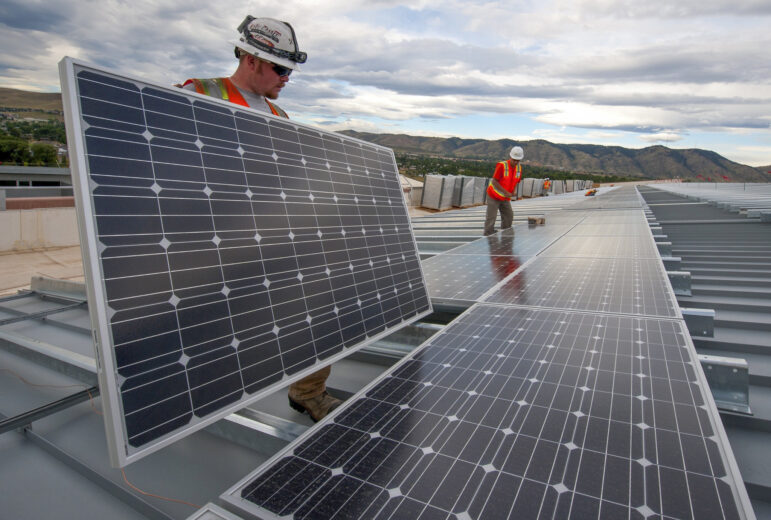

Protests in London demonstrate against that country's policy of new oil imports. Image: Alisdare Hickson, Creative Commons via Flickr
Reporting Guide to Holding Governments Accountable for Climate Change Pledges — Chapter 3: Are Commitments Being Kept?
Read this article in
Chapter Guide Resource
Reporting Guide to Holding Governments Accountable for Climate Change Pledges — Introduction
Periodic reports sent in by governments to the United Nations Framework Convention on Climate Change (UNFCCC) are the places to dig out the official data on emissions, and more.
These reports include information on:
- Greenhouse gas (GHG) emissions.
- Actions taken to reduce emissions.
- Steps to adapt to climate change.
- Aid to countries most affected by climate change.
What’s more, UNFCCC reviews of these reports offer insights into their sufficiency and accuracy. The UNFCCC summarizes the GHG inventory data submitted by the parties, with multiple options for analyzing it. The UNFCCC page, Greenhouse Gas Inventory Data, is searchable by country, type of emissions, year, industry, and more.
But be prepared for complexity. These reports are not easy reading. They contain lots of numbers, and they are steeped in bureaucratic and scientific jargon.
“The existing reporting arrangements are fairly technical in nature, which may limit non-experts and the general audience from understanding what has been the Parties’ climate progress,” noted a 2022 report by The Council on Energy, Environment and Water (CEEW), an NGO in India.
The inventories submitted in 2022 include data to 2020 from a “base year” designated by each country, so these start dates vary. (See the UNFCCC guide on base years.) Some countries have been accused of strategically picking their base year to make their progress look better.
These country reports are accompanied by Common Reporting Format (CRF) tables containing the emissions data.
To help digest the complex material, reporters would be well advised to solicit expert assistance. Scientists, climate change activists, and government specialists can assist reporters in interpreting the data. Experts may be found in university departments such as environmental studies, meteorology, biology, and economics.
UN Reports Are Evolving, Converging
The UNFCCC reporting regime is continuing to evolve toward more uniformity. On the near horizon is the Enhanced Transparency Framework (ETF), the name for an updated system for reporting. This will result in some new reports, which could be of interest to investigators.
Under the ETF, all governments will submit a Biennial Transparency Report by the end of 2024 using common reporting tables and formats. Least developed countries (LDCs) and small island developing states (SIDS) can submit at their discretion. (For more about the ETF see the 2020 ETF Handbook and the 2022 Manual.) Another option: this video explainer by the Consultative Group of Experts (CGE), a UN body that helps developing countries.

The 46 Least Developed Countries (LDCs) — designations as of October 2022 — have different climate commitment reporting requirements than other nations in the Global South. Image: UN Conference on Trade and Development
In the meantime, governments are continuing to submit reports. Their type and content varies by the development level of the country. (See UNFCCC description on definitions and categories of development.)
Below is a closer look at the reports and where to find them.
Overview of Key Reporting Documents
The 43 Annex I countries generate:
- National Inventory Reports (NIRs) every year.
- Biennial Reports (BRs) every two years.
Developing (Non-Annex I) countries create:
- Biennial Update Reports (BURs). These should be submitted every two years except for the least developed countries (LDCs) and small island developing states (SIDS), giving them some discretion.
- National Communications, including a GHG inventory. Again these should be submitted every four years, but submission is conditional on provision of funding to cover the cost of preparation.
Now let’s look at each of these, and where to find them.
Developed Country Reports: National Inventory Reports (NIRs)
National Inventory Reports (NIRs) are submitted annually by the Annex I countries and are due by April 15 of each year.
NIRs “contain detailed descriptive and numerical information and the CRF (common reporting format) tables contain all greenhouse gas (GHG) emissions and removals, implied emission factors and activity data,” according to a UNFCCC description. These reports can be large. For example, the 2022 Austrian NIR runs to over 850 pages. See the full inventory of NIRs.
NIRs cover these emissions:
-
- Carbon dioxide (CO2)
- Methane (CH₄)
- Nitrous oxide (N₂O)
- Perfluorocarbons (PFCs)
- Hydrofluorocarbons (HFCs)
- Sulfur hexafluoride (SF6)
- Nitrogen trifluoride (NF3)
They also cover five sectors:
-
-
- Energy
- Industrial processes and product use
- Agriculture
- Land use
- Land-use change and forestry
- Waste
-
Also on these pages, for each country, are detailed tabular presentations:
-
-
- Common reporting format (CRF) tables
- Standard electronic format (SEF) tables
- Status Reports (prepared by the Secretariat, essentially check lists about each country’s submission)
-
There’s a lot of detail in these reports, as summarized on a UNFCCC page on Reporting Requirements.
Developed Country Reports: Biennial Reports (BRs)
The Annex I developed countries also file Biennial Reports, which are less detailed summaries of progress. (For example, the 2022 Austrian BR is 77 pages long.) They contain information about emission reductions, mitigation actions, projected emissions, and more. The latest BRs, the fifth round (BR5), were to be submitted no later than Dec. 31, 2022.
See the web pages for the Fifth Biennial Reports and the Fourth Biennial Reports. For the dates of past biennial reports, see the UNFCCC’s latest summary report, from April 2022.
The reporting countries also provide the data in a tabular format.
The UNFCCC’s most recent description of the content of all the Biennial Reports is a Compilation and Synthesis Report 2020. Among other things, the 2020 report states, “Annex I Parties are progressing towards their 2020 emission reduction targets, but gaps to those targets remain for some.” The report includes bar charts showing each country’s data.
Support for Developing Countries Disclosed
What support are developed countries providing to help less developed countries affected by climate change?
A subset of the Annex I developed countries are supposed to provide this data in their BRs. These are the so-called Annex II countries, 24 of them.
The tabular reports describe the provision of financial, technological, and capacity-building support. (See Tables 7, 8, and 9.) They use common tabular formats (CTFs) in accordance with the “UNFCCC biennial reporting guidelines for developed country Parties.”
In addition, under Article 9.5, developed countries were asked to biennially communicate “indicative quantitative and qualitative information, as applicable, including, as available, projected levels of public financial resources to be provided to developing country Parties.” These “Biennial Communications” (BCs), only 10 so far, are logged with the UNFCCC.
Developing Countries Reports: Biennial Update Reports (BURs)
Somewhat different reports are provided by developing countries, the Non-Annex I Parties.
They submit Biennial Update Reports containing updates of GHG inventories, including a national inventory report, plus information on mitigation actions, needs, and support received.
These reports “provide updates on actions undertaken by a Party to implement the Convention, including the status of its GHG emissions and removals by sinks, as well as on the actions to reduce emissions or enhance sinks,” according to the UNFCCC’s descriptive page. Carbon sinks, such as the ocean, soil, and forests, absorb carbon dioxide from the atmosphere.

Surfers gather off the southern coast of Australia to protest an oil company’s plans for offshore drilling in the Great Australia Bight. Image: Lachlan Gardiner, Creative Commons, Climate Visuals Countdown
Submitting BURs is discretionary for the LDCs and SIDS, who have argued that some of the reporting requirements are burdensome.
The BURs are due by December in even numbered years starting in 2014. But some countries only submitted their first reports in 2022.
The Institute for Global Environmental Strategies (IGES), a Japanese organization, in February 2022 updated a database on the Biennial Update Reports (BURs) submitted by developing countries. The database covers GHG inventory, mitigation actions, and international market mechanisms, support needed, and support received. It includes information from 111 BURs submitted by 63 countries.
 Toby McIntosh is a senior advisor for GIJN’s Resource Center, which provides online resources to journalists worldwide. He was the editor of FreedomInfo.org, (2010-2017) a nonprofit website based in Washington, D.C. that covers international transparency laws. He was with Bloomberg BNA for 39 years and has filed numerous US Freedom of Information requests and has written about FOI policies worldwide. He is a steering committee member of FOIANet, a network of FOI advocates.
Toby McIntosh is a senior advisor for GIJN’s Resource Center, which provides online resources to journalists worldwide. He was the editor of FreedomInfo.org, (2010-2017) a nonprofit website based in Washington, D.C. that covers international transparency laws. He was with Bloomberg BNA for 39 years and has filed numerous US Freedom of Information requests and has written about FOI policies worldwide. He is a steering committee member of FOIANet, a network of FOI advocates.
















